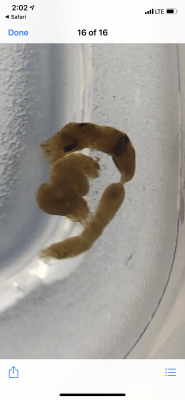Navigation
Install the app
How to install the app on iOS
Follow along with the video below to see how to install our site as a web app on your home screen.
Note: This feature may not be available in some browsers.
More options
You are using an out of date browser. It may not display this or other websites correctly.
You should upgrade or use an alternative browser.
You should upgrade or use an alternative browser.
Help Identifying
- Thread starter WilliamTideReefer
- Start date
- Tagged users None
Maybe a peanut worm or a feather duster out of it's tube, with no crown.
Is it alive or dead?
Is it alive or dead?
- Joined
- May 28, 2020
- Messages
- 18
- Reaction score
- 3
It’s not moving so I assume dead.Maybe a peanut worm or a feather duster out of it's tube, with no crown.
Is it alive or dead?
- Joined
- May 28, 2020
- Messages
- 18
- Reaction score
- 3
Nothing it doesn’t even move. Tank is about 6 weeks old.What does it do if you poke it?
Tanks has:
Two Clownfish
One Diamond Goby
Two Snails
If you didn't have a feather duster then my guess is a dead peanut worm. Someone else here might have a better idea though.
Highly likely that it is a vermetid snail shell. They're an annoying pest that proliferate in any system that is heavily broadcast fed. To control populations, the shells can either be crushed or sealed with cyanoacrylate gel. If left unchecked, they can reproduce and spread at a rapid pace to the point where the slime nets they cast -- 2 - 5" long, irritate nearby corals.
Oops. Forgot to include the photo.

- Joined
- May 28, 2020
- Messages
- 18
- Reaction score
- 3
Can you elaborate on broadcast fed?Highly likely that it is a vermetid snail shell. They're an annoying pest that proliferate in any system that is heavily broadcast fed. To control populations, the shells can either be crushed or sealed with cyanoacrylate gel. If left unchecked, they can reproduce and spread at a rapid pace to the point where the slime nets they cast -- 2 - 5" long, irritate nearby corals.
- Joined
- May 28, 2020
- Messages
- 18
- Reaction score
- 3
SoftIs it hard like a snail shell or soft and squishy?
Can you elaborate on broadcast fed?
Of course. Broadcast feeding is mixing any small particle food, coral foods in particular (Polyp Lab, for instance) with a bit of tank water then pouring it into the system with the main pump off, allowing the internal circulation to disperse it, then turning off those pumps as well. It's popular with those that have large SPS populations as it is an ideal way to feed SPS, particularly in larger sytems.
- Joined
- Feb 28, 2020
- Messages
- 356
- Reaction score
- 358
If it's soft and squishy than it's not a vermetid snail. Their tubes are their shells, and they are hard. As for what it is, I'm not sure. #reefsquad
- Joined
- May 28, 2020
- Messages
- 18
- Reaction score
- 3
Awesome thanks for teaching me something today!Of course. Broadcast feeding is mixing any small particle food, coral foods in particular (Polyp Lab, for instance) with a bit of tank water then pouring it into the system with the main pump off, allowing the internal circulation to disperse it, then turning off those pumps as well. It's popular with those that have large SPS populations as it is an ideal way to feed SPS, particularly in larger sytems.
Soft
Oops. Didn't see this post. If it's soft, it is definitely not a vermetid but at least now you know what to do if you're unfortunate enough to encounter one.
Awesome thanks for teaching me something today!
Absolutely my pleasure. Always happy to help.
Similar threads
- Replies
- 2
- Views
- 161
- Replies
- 3
- Views
- 268
- Replies
- 3
- Views
- 262


















